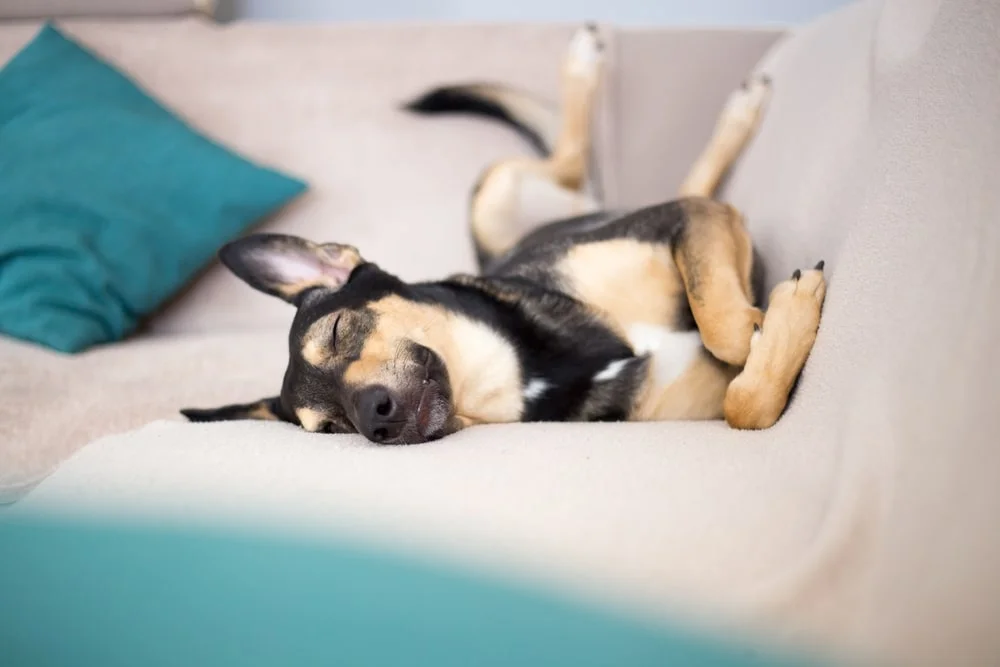PET HEALTH
Bloat in Dogs: Causes, Symptoms, & Surgery Cost
Bloating in dogs isn’t the same as it is in humans. While human bloat usually just means a distended stomach, canine bloat refers to the distension and twisting of the stomach.
Bloat in dogs is a medical emergency that may require intravenous (IV) fluids or immediate surgery, and emergency vet costs are usually high. Dog bloat surgery can cost around $2,000 – $7,500, depending on your location, vet, and the severity of your dog’s condition.1
Read on to learn what bloat is, which dogs are susceptible to it, some symptoms to watch for, and treatment options.
What Is Bloat in Dogs?
Bloat — formally called gastric dilatation and volvulus (GDV) — is a painful medical emergency that mainly occurs in large, deep-chested dogs.2 The combination of these two separate conditions is what creates a severe medical crisis. Let’s break them down.
Gastric dilatation
This is when your dog’s stomach becomes distended. Gastric dilatation is usually caused by eating or drinking large amounts of water quickly. Stress and exercise soon after eating, as well as anxiety, may also be contributing factors. This results in gas, which causes the distention.2
Volvulus
This is when a distended stomach progresses into a twisted stomach. When your dog’s stomach flips or twists, it cuts off blood flow. It also blocks the vena cava, which carries blood through the back half of the body to the heart. Dogs who experience bloat go into shock as their bodies are deprived of blood flow.2
Symptoms of Bloat in Dogs
Bloat can come on fast, within 2 – 3 hours after the triggering incident, and quickly turn into a medical emergency.2 Watch out for these signs of GDV in dogs:3
- Restlessness
- Drooling
- Swollen stomach
- Anxiety
- Looking at their stomach
- Pacing
- Trying to vomit but nothing comes up
As the condition worsens, your dog may also exhibit signs of shock:
- Collapse
- Pale gums
- Rapid heartbeat
- Shortness of breath
- Weakness
Treatment for Bloat in Dogs
Immediate emergency care is crucial for dogs with GDV. Keep your dog warm and still on your way to the animal hospital, since they may be in shock. When you arrive, your vet will likely start your dog on IV fluids to help reverse the shock.2 Then, they can take X-rays to properly diagnose your dog and see how severe their condition is.
The first step to treating bloat is reducing the pressure on the stomach. Your vet has two options for doing this. Depending on how twisted your dog’s stomach is, the vet will either thread a tube down their throat or insert a large gauge needle directly into their stomach. Both methods release the gas buildup.2
If your dog’s stomach is twisted, the vet will then have to perform emergency GDV surgery to untwist it. During the surgery, they may also remove any dead stomach tissue and perform a gastropexy. This is when the vet sutures the stomach to the abdominal wall. Attaching the stomach to the body wall helps prevent volvulus in the future.2
How To Prevent Bloat in Dogs
Some vets recommend that dogs who are more susceptible to bloat, especially Great Danes, get a prophylactic gastropexy. This is a preventative surgery vets can do at the time of spaying for female dogs or neutering for male dogs. Rather than waiting for the stomach to twist, the vet will suture it to the abdominal wall, so the stomach is less likely to twist enough to cut off blood flow in the future.2
What dog breeds are susceptible to bloat?
While bloat is a potential risk for all dogs, it most frequently occurs in large, deep-chested breeds or mixed-breeds with hollow chests due to their breed combination. Here are some at-risk breeds:2
- Basset hounds
- Doberman pinschers
- Gordon setters
- Great Danes
- Irish setters
- Old English sheepdogs
- Saint Bernards
- Standard poodles
- Weimaraners
Pet Insurance May Help Cover Canine Bloat Costs
Emergency GDV surgery with a gastropexy is an expensive procedure, often costing between $2,000 and $7,500.1 However, GDV is life-threatening, and often the only other option is euthanization if treatment isn’t affordable — a heartbreaking decision no pet owner should ever have to make because of costs.
This is where dog insurance can help. Emmy, a 6-year-old mixed dog from Florida, had GDV and was rushed to the animal hospital. The surgery cost over $3,500, but her family had a dog insurance policy. MetLife Pet Insurance reimbursed them for over $2,600 of the GDV surgery cost.4
Whether your dog is at a higher risk and you opt for a prophylactic gastropexy, or your dog needs GDV emergency surgery, pet insurance may help make expensive vet bills more affordable. Learn how pet insurance works or fetch your personalized quote today.

